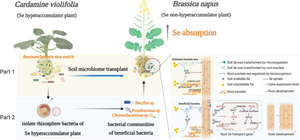Biology and Fertility of Soils ( IF 5.1 ) Pub Date : 2024-07-17 , DOI: 10.1007/s00374-024-01846-5 Huan Zhang , Dandan Yang , Chengxiao Hu , Xiaoping Du , Lianming Liang , Xu Wang , Guangyu Shi , Chuang Han , Yanni Tang , Zheng Lei , Ceng Yi , Xiaohu Zhao

|
It is unknown whether soil microbiota and soil bacteria isolated from the rhizosphere of selenium hyperaccumulator plants can affect selenium absorption by selenium non-hyperaccumulator plants. Here, we used pot experiments and split root experiments to investigate the role of soil microbiota and isolated rhizosphere bacteria from a selenium hyperaccumulator plant (Cardamine violifolia) in affecting selenium absorption by a selenium non-hyperaccumulator plant (Brassica napus), combining root metabolism analysis, microbiome profiling, strain isolation and its selenium absorption functional validation. We found that soil microbiota of Cardamine violifolia significantly increased the root selenium content by 31.8% and regulated root exudation by Brassica napus. Additionally, the application of upregulated long-chain organic acids + amino acids, long-chain organic acids + short-chain organic acids, ethanolamine, and 2-ketobutyric acid increased the selenium contents in the roots of Brassica napus by 69.6%, 38.4%, 81.2%, and 48.8%, respectively. Further investigation revealed that dominant bacteria were significantly enriched in the rhizosphere of C. violifolia compared to B. napus. After that, we isolated the rhizosphere bacteria of Cardamine violifolia and observed that Bacillus sp.-2, Chryseobacterium sp., and Pseudomonas sp., as well as their combined communities, significantly improved selenium absorption in Brassica napus. Moreover, the combined bacterial communities significantly regulated specific-root metabolism, enhanced rhizosphere soil available selenium content, promoted root development, increased expression levels of genes encoding selenium transporter in root. These findings provide insights into utilizing rhizosphere bacteria of selenium hyperaccumulator plants to increase selenium absorption by non-hyperaccumulator plants.
Graphical Abstract
中文翻译:

来自硒超积累植物根际的细菌可以提高非超积累植物对硒的吸收
目前尚不清楚从硒超积累植物根际分离的土壤微生物群和土壤细菌是否会影响硒非超积累植物对硒的吸收。在这里,我们采用盆栽实验和分根实验,结合根系代谢分析,研究土壤微生物群和硒超积累植物(碎米荠)根际分离细菌对硒非超积累植物(甘蓝型油菜)吸收硒的影响。 、微生物组分析、菌株分离及其硒吸收功能验证。我们发现碎花米的土壤微生物群使根部硒含量显着增加了 31.8%,并调节甘蓝型油菜的根部分泌。另外,施用上调的长链有机酸+氨基酸、长链有机酸+短链有机酸、乙醇胺、2-酮丁酸使甘蓝型油菜根部硒含量分别提高69.6%、38.4% 、 81.2% 和 48.8% ,进一步研究发现,与甘蓝型油菜相比,大叶油菜根际优势菌显着富集。之后,我们分离了碎米荠的根际细菌,观察到芽孢杆菌属 sp.-2、金黄杆菌属 sp. 和假单胞菌属 sp. 及其组合群落显着提高了甘蓝型油菜的硒吸收。此外,组合的细菌群落显着调节根部特定代谢,提高根际土壤有效硒含量,促进根系发育,提高根部编码硒转运蛋白基因的表达水平。 这些发现为利用硒超积累植物的根际细菌来增加非超积累植物对硒的吸收提供了见解。































 京公网安备 11010802027423号
京公网安备 11010802027423号